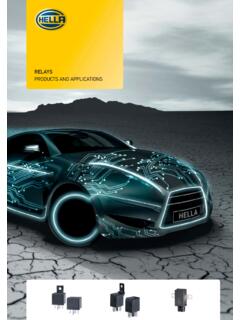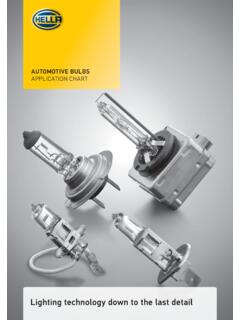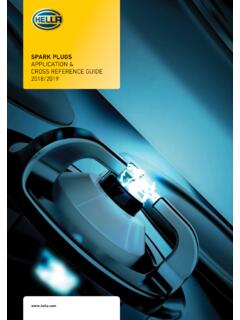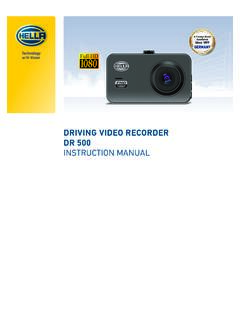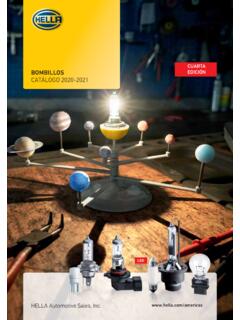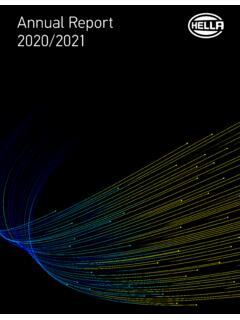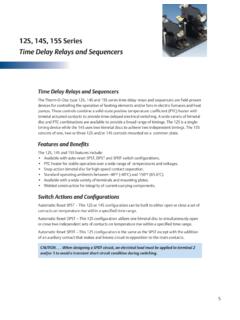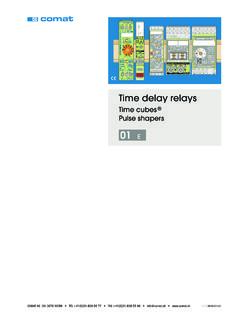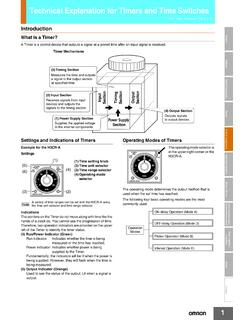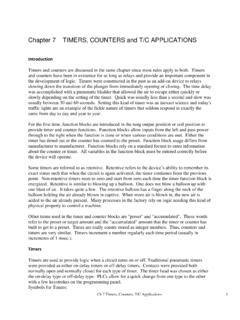Transcription of RELAYS AND RELAY DEVICES PRODUCTS AND APPLICATIONS
1 RELAYS AND RELAY DEVICESPRODUCTS AND |32 INTRODUCTION 2A small component with a big history .. 4 How HELLA checks and ensures quality .. 7 ELECTROMECHANICAL RELAYS 8 Explanation and uses .. 8 RELAY types .. 12 Mini RELAY 12 V make contact with holder .. 13 Mini RELAY 12 V, make contact without holder .. 14 Mini RELAY 12 V, change-over contact with holder .. 15 Mini RELAY 12 V, make contact without holder .. 16 Mini RELAY 24 V make contact with holder .. 17 Mini RELAY 24 V, make contact without holder .. 18 Mini RELAY 24 V, change-over contact with holder .. 19 Mini RELAY 24 V, make contact without holder .. 20 MICRO RELAY 22 Micro RELAY 12V, make contact without holder / change-over contact without holder .. 22 Micro RELAY 24V, change-over contact without holder ..23 HIGH POWER RELAY 24 High-power RELAY 12V, make contact with holder/without holder.
2 24 High-power RELAY 24V, make contact with holder/without holder .. 25 BATTERY DISCONNECT RELAY /SOLID STATE RELAY 26 Battery disconnect RELAY and solid state RELAY 12V, make contact .. 26 Summary of battery disconnect and solid state RELAYS .. 27 TECHNICAL DATA 28 Technical data of the RELAYS Overview .. 28 Climatic and mechanical tests .. 30 FLASHER UNITS 32 Explanation and uses .. 32 Test circuits .. 36 Flasher unit 6V, 4-pole and 12V, 3-pole .. 38 Flasher unit 12V, 3-pole .. 39 Flasher unit 12V, 4-pole .. 40 Flasher unit 12V, 5-pole/6-pole .. 41 Flasher unit 12V, 6-pole/7-pole .. 42 Flasher unit 24V, 3-pole/4-pole .. 43 Flasher unit 24V, 4-pole/5-pole .. 44 Flasher unit 24V, 6-pole/7-pole .. 45 Flasher unit 24 V, 11-pole and 12/24 V, 6-pole .. 46 LED fl asher unit 12/24V, 3-pole; 12V, 4-pole/5-pole and 24V, 4-pole.
3 47 Overview of fl asher unit technical data .. 48 Legal regulations for fl asher units .. 48 LED indicators and failure control from HELLA .. 49 The right solution for your vehicle electronics .. 50 WASH/WIPE INTERVAL CONTROL UNITS 52 Explanation and uses .. 52 Wash/wipe interval control units 12V .. 54 Wash/wipe interval control units 24V .. 55 Headlight cleaning system 12V/24V .. 56 CLOCK RELAYS 58 Explanation and uses .. 58 Clock RELAYS 12V .. 60 Clock RELAYS 24V .. 61 ACCESSORIES 62 Overview .. 62 SWITCHING AND PLUG MATRICES 64 Circuit diagrams electromechanical RELAYS .. 64 Pin diagrams electromechanical RELAYS .. 65 Pin diagrams fl asher units .. 66 Pin diagrams wash/wipe interval control units .. 67 Pin diagrams clock RELAYS .. 67 Pin diagrams control units for headlight cleaning systems.
4 67 HELLA ROCKER SWITCHES 68 The new HELLA switch confi gurator .. 68 Rocker switch, 3100 series.. 70 Switch functions .. 71 INTRODUCTIONA small component with a big historyFrom the telegraph to automotive engineering The RELAY owes its name to former times when mail was still carried by horse. At what were known as RELAY stations, post riders could swap their horses for rested ones. Today, we call an electromagnetic, remotely operated switch a RELAY . The American physician Joseph Henry invented the electric RELAY in 1835. The pioneer in communications engineering used it to send messages from his laboratory to his home. RELAYS were first used on a larger scale in 1837, as signal amplifiers for Samuel Morse s recording telegraphs. They would later make possible the widespread use of telephones and became a cornerstone of safety in railway engineering.
5 In 1941, Konrad Zuse utilised 2,000 RELAYS in his legendary Z3, the first digital computer. HELLA produced its first automotive RELAY in 1960. As electronics matured in the 20th century, the age of the RELAY was often seen as over; nevertheless, they retain a place in specific APPLICATIONS . The automotive industry, for example, needs RELAYS , since RELAY functions cannot always be replaced by control units. Only RELAYS make galvanic isolation possible between input and output. Semi-conductors cannot manage this at the moment. The cost advantage RELAYS have over electronic solutions is also unbeatable. RELAYS are used in automotive engineering to switch high currents. The engine control unit, for example, is switched by a RELAY . Because RELAYS are robust and not particularly susceptible to failure, they can be installed near electric DEVICES .
6 They require only low control currents, making small line cross-sections sufficient. The switching and amplifier function of a RELAY could only be achieved with a lot more effort and a lot less reliability using more modern electronics. Another benefit of the RELAY is that it is quick and easy to replace. These positive characteristics are the reason why RELAYS are still in use. And they ensure that, in the future, RELAYS will still be at home in many have been used to remotely control circuits for over 180 years. The technology has proven its reliability millions of times and is today still the first choice for many APPLICATIONS , such as in automotive RELAYS from HELLA versatile and reliable Manufacturing expertise: HELLA produces more than 100 million units per year at its own facilities thanks to optimised production at an attractive price and with one of the lowest failure rates in the entire industry.
7 Flexibility: Large volumes are produced in a fully automated process, small volumes with semi-automation. This means we are in a position to change over quickly to semi-automatic production. HELLA is able to respond promptly to customer requirementsand create new variants in addition to its existing product range at short notice. OEM customers: HELLA develops and produces RELAYS for AGCO, Claas, Daimler AG, Ford, VW, GM, JCB, Opel/Vauxhall, Nissan, John Deere, Chrysler, Jaguar/Land Rover and others. Many of our customer relationships have existed for decades. Production locations: Berlin (Germany); Flora, Illinois (USA); Xiamen (China).|541951 First hot-wire flasher unit1960A- RELAY with metal threshold voltage controller for windshield wipers1965E- RELAY : the first fully electronic flasher unit1968L- RELAY : the first modular system1969 Wipe/wash interval control unit1970K- RELAY : current controlled RELAY for direction indicator lampsBi-stable RELAY for switching between low and high beam1972Q- RELAY with plastic base plate, also available with built-in fuse1973V- RELAY : PCB RELAY for automatic placement1976S1- RELAY : replacement for Q- RELAY .
8 Can be produced fully automatically, also available with built-in fuse1978H- RELAY : high-power RELAY for different motor loads1982 Sounding RELAY for controlling direction indicator lamps1989 Round connector RELAY : specially produced for Daimler AG, with plastic housing1994 Micro RELAY : designed for fully automated production1998 Mini solid state relay2003Bi-stable battery disconnect RELAY with flexible attachment system2005 Micro RELAY : high-current and bi-stable version2006 Intelligent flasher units for active LED flashers with current pulse evaluation in acc. with ISO 13207-12008 Flasher unit with microprocessor technology2012 New and refined RELAY PRODUCTS with lower power consumption to help reduce CO2 emissionsINTRODUCTION|76 How HELLA checks and ensures quality1) Load curve, 20 A resistive 10 A 500 ms1) Load curve, 3 x high beam 10 A 500 msTime (minutes)Temperature ( C)Relative humidity (%) Design life tests:The RELAYS are switched on/off in cycles on fully automated test racks.
9 Original loads or simulated resistive, inductive, capacitive or combined loads whose current characteristics are recorded as the original loads are connected. In addition, the RELAYS can be subjected to different ambient temperature ranges or temperature profiles. The test is continuously documented. Electrical parameters:Within the context of product release, starting voltage, dropout voltage, contact voltage drop, coil resistance and insulation resistance are tested, for example. Accompanying the manufacturing process, the electrical parameters are recorded at the end of the production process by end-of-line testers. These can be evaluated statistically. One important factor for guaranteeing the consistent high quality of the RELAYS produced. Environmental and mechanical tests:Every RELAY has to pass tests such as the alternating temperature test, salt spray fog test, mechanical shock test or drop test and the vibration test within the context of the product release process.
10 These tests are carried out using HELLA equipment. Analytical tests:Here, the materials used and the different connecting processes such as soldering and welding are tested. The tests are carried out randomly during incoming goods testing and following production. Certificates:HELLA has been certified in a range of relevant areas DIN EN ISO 9001:2008, ISO / TS 16949:2009, ISO 14001. HELLA RELAYS also comply with the ROHS (2002/95/EC) and REACh RELAYSE xplanation and usesKey components of an electromechanical relayLegendContact platesArmaturePins for coil wireSwitch contactsCoil made of Cu wireIron core (in the coil)Blade terminal (load) made of E-Cu (electrolytic copper) with tin-plated surfaceBlade terminal (coil) made of CuZn (brass) with tin-plated surfaceBase plateCoil bodyYoke|98 Functional principleRelays are basically electrically operated switches which use an electromagnet to move a switching mechanism by switching one or more contacts.
